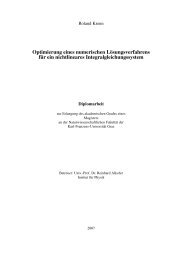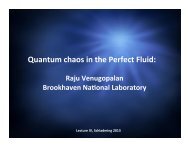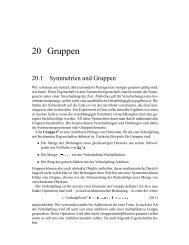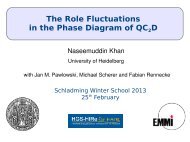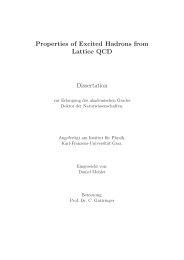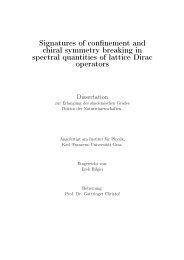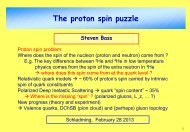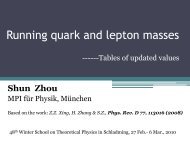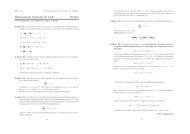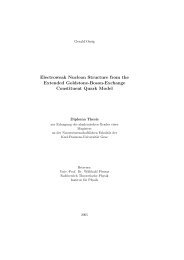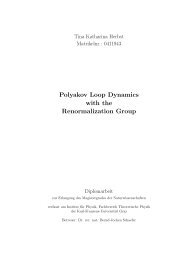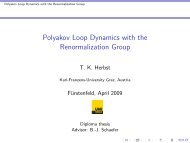The QCD Quark Propagator in Coulomb Gauge and - Institut für Physik
The QCD Quark Propagator in Coulomb Gauge and - Institut für Physik
The QCD Quark Propagator in Coulomb Gauge and - Institut für Physik
Create successful ePaper yourself
Turn your PDF publications into a flip-book with our unique Google optimized e-Paper software.
Chapter 3. Remarks on <strong>QCD</strong> <strong>in</strong> <strong>Coulomb</strong> <strong>Gauge</strong> 17<br />
like 1/ √ a, but they cancel pairwise <strong>in</strong> each order <strong>in</strong> perturbation theory by virtue of the<br />
r-symmetry. <strong>The</strong>refore <strong>in</strong> the <strong>Coulomb</strong> gauge limit the correlation functions are f<strong>in</strong>ite,<br />
which rema<strong>in</strong>s true for the renormalised correlation functions. However, one-loop graphs<br />
are identified that vanish like √ a <strong>and</strong> that do not exist <strong>in</strong> the formal <strong>Coulomb</strong> gauge,<br />
i.e. a = 0. <strong>The</strong>se graphs cannot be neglected s<strong>in</strong>ce they give a f<strong>in</strong>ite contribution when<br />
<strong>in</strong>serted <strong>in</strong>to the graphs that diverge like 1/ √ a. It is still possible that these two-loop<br />
graphs, which are not existent <strong>in</strong> the formal <strong>Coulomb</strong> gauge, are mere gauge artefacts <strong>and</strong><br />
decouple from expectation values of all gauge-<strong>in</strong>variant quantities such as a Wilson loop.<br />
However, up to now it was not possible to show this.<br />
3.3 Approaches <strong>in</strong> <strong>Coulomb</strong> gauge<br />
Work<strong>in</strong>g perturbative calculations are desirable <strong>in</strong> every gauge. However, <strong>in</strong> <strong>Coulomb</strong><br />
gauge no further <strong>in</strong>sight has been achieved with the st<strong>and</strong>ard dimensional regularisation<br />
technique. <strong>The</strong> reason for this is, that the gauge boson propagator is of the form<br />
[<br />
G ab<br />
µν (q) = −iδab g<br />
q 2 µν + n2<br />
q 2q µq ν − q · n ]<br />
q (q µn 2 ν + n µ q ν ) , (3.2)<br />
where n µ = (1, 0, 0, 0). It generates loop <strong>in</strong>tegrals with the expression<br />
∫<br />
d D q<br />
q 2 (q − p) 2 . (3.3)<br />
<strong>The</strong> energy <strong>in</strong>tegral is not def<strong>in</strong>ed, even if one uses dimensional regularisation.<br />
A procedure called split dimensional regularisation for this ill-def<strong>in</strong>ed <strong>in</strong>tegrals was<br />
brought up <strong>in</strong> [LW96]. Here energy <strong>and</strong> 3-momentum <strong>in</strong>tegrals are separately dimensionally<br />
regularised. Two regulat<strong>in</strong>g parameters are <strong>in</strong>troduced by splitt<strong>in</strong>g the dimensionality<br />
of space-time <strong>in</strong>to two different sectors, namely, D = 4 − 2ǫ = ω + ρ <strong>and</strong> the divergences<br />
conta<strong>in</strong>ed <strong>in</strong> the energy <strong>in</strong>tegrals are expressed as poles <strong>in</strong> ρ besides the usual ones <strong>in</strong><br />
terms of ω. In this approach <strong>Coulomb</strong> gauge <strong>in</strong>tegrals were studies up to one <strong>and</strong> two-loop<br />
level <strong>and</strong> results for the divergent part of several of them were obta<strong>in</strong>ed. This concept of<br />
splitt<strong>in</strong>g up the dimensions is also used together with the so-called negative dimensional<br />
<strong>in</strong>tegration method [SS01]. With these methods comb<strong>in</strong>ed results at the one <strong>and</strong> two loop<br />
level for arbitrary exponents of propagators <strong>and</strong> dimension have been achieved.<br />
In recent years the Yang-Mills sector of <strong>QCD</strong> was exam<strong>in</strong>ed <strong>in</strong> the Schröd<strong>in</strong>ger picture<br />
[FR04a, FR04b, RF05, ERS06]. Us<strong>in</strong>g canonical quantisation a comb<strong>in</strong>ation of <strong>Coulomb</strong><br />
<strong>and</strong> Weyl gauge is fixed with the Faddeev-Popov method. In this approach the functional



